"Breakfast Breads"
January 21,
2010 - Vol 2, Issue 02
| |
|
| Farmer's Market
|
|
2010
DBA
Farmer's Market The Elko DBA is
working on an annual Farmer's Market to start in July of
2010. If you interested in volunteering, becoming a
vendor, or would just like general information, email
Amber at: elkofarmersmarket
@yahoo.com
| |
|
Good
Morning!
|
"Breakfast is the most
important meal of the day!" These words, from hundreds
of mothers everywhere, linger in our minds. "Breaking
the fast" is one of our most favorite mealtimes. After
eight or so hours, food tastes particularly good! The
range of possibilities extends from simple to complex.
In this issue, we focus on some of our favorite
breakfast breads that are perfect any time of day. 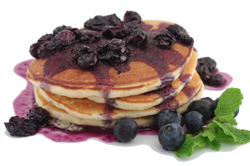 If it's been awhile since you've
had fresh waffles or homemade pancakes, you'll be
delighted to become reacquainted with these pleasures.
This edition focuses on just a few of the breakfast
bread options available and delves into the secrets for
mixing up all kinds of yummy quick breads. We finish
with some great recipes for waffles, pancakes, and
morning muffins. It's just the tip of the iceberg as far
as breakfast possibilities go, but not a bad place to
start for rediscovering fresh, homemade
breakfasts! If it's been awhile since you've
had fresh waffles or homemade pancakes, you'll be
delighted to become reacquainted with these pleasures.
This edition focuses on just a few of the breakfast
bread options available and delves into the secrets for
mixing up all kinds of yummy quick breads. We finish
with some great recipes for waffles, pancakes, and
morning muffins. It's just the tip of the iceberg as far
as breakfast possibilities go, but not a bad place to
start for rediscovering fresh, homemade
breakfasts!
|
Upcoming
Events
|

|
| January Wine of the
Month |
|
Our
annual ode to
Cowboy Poetry Month in
Elko:
WILY
JACK

Available in:
Chardonnay,
Zinfandel, and Cabernet Sauvignon
NOW $8 per Bottle!
More information:
http://www.wilyjack.com/index.cfm |
Cucina Fresca's January
Clearance Specials
|

|
| Feed a
Family |
|
Bring a
Bag and Feed a
Family!
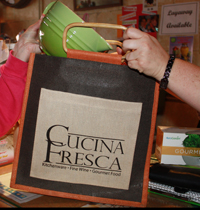 Each time you make a purchase and
bring your own bag, we will drop a dime in a jar on our
counter. All dimes collected from the jar will be
donated to the F.I.S.H. Food bank to feed Northeastern
Nevada families in need. Each time you make a purchase and
bring your own bag, we will drop a dime in a jar on our
counter. All dimes collected from the jar will be
donated to the F.I.S.H. Food bank to feed Northeastern
Nevada families in need.
With your
generous help we raised $291
throughout the holidays for the F.I.S.H Food Bank. Thank
you!
|
E-News Drawing
|
If you
receive our newsletter, you will be entered into a
drawing each month for a great prize for your
kitchen. Check here each month to see if you have
won, if so, come in to collect your prize!
December's
winner:
Laura Kelly
Congrats, Laura, come by anytime to
pick up your
prize!
| | |
|
The Quick in Quick
Bread!
|
Many
breakfast breads fall into the category of bread known as
"quick breads." Unlike yeast-based breads that take time for
the yeast to work its magic, quick breads produce immediate
results. 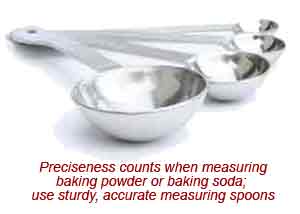 The chemistry behind quick breads is
interesting, and a basic understanding of what's going on will
help produce excellent outcomes every time. The chemistry behind quick breads is
interesting, and a basic understanding of what's going on will
help produce excellent outcomes every time.
At its most
basic level, bread is grain flour restructured around air
bubbles. Creating, growing, and capturing air bubbles is the
magic of making any bread. For yeast-based breads, the yeast
"breathes" out carbon dioxide as it multiplies in sitting
dough. In contrast, quick breads rely on a natural, immediate
chemical reaction from baking soda and/or baking powder to
produce carbon dioxide. In either case, the carbon dioxide
expands the bubbles already present from the mixing process.
Both liquid and heat can activate these substances into
producing carbon dioxide gas. The expanded bubbles are
captured as the dough is baked and as the flour's proteins
harden around the little air pockets.
Baking Soda - Baking soda is
sodium bicarbonate. When in contact with liquid and heated, it
dissolves into carbon dioxide gas and sodium carbonate. The
carbon dioxide expands air bubbles already present in the
batter, while the sodium carbonate remains behind as a
slightly alkaline substance that is neutralized by any acidic
ingredient in the batter such as sour cream, buttermilk, or
citrus juice, etc.
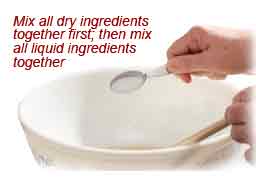 Baking Powder - Baking powder
is a combination of baking soda, some type of powdered acid,
and cornstarch. In one teaspoon of baking powder, there is
only 1/4 teaspoon of baking soda. The baking soda produces
carbon dioxide gas while the acidic component neutralizes the
remaining sodium carbonate. The cornstarch keeps the powders
mixed and dry. The acidic component of baking powder is
matched in strength to the amount of baking soda present so
that the end result is neutral to the batter. The acidic
component is also responsible for when and how quickly baking
powder acts once in contact with liquid. Fast-acting baking
powder produces gas immediately upon contact with liquid.
Slow-acting baking powder inspires the release of gas only
when heated. Double-acting baking powder has two different
acidic components that do both. Baking Powder - Baking powder
is a combination of baking soda, some type of powdered acid,
and cornstarch. In one teaspoon of baking powder, there is
only 1/4 teaspoon of baking soda. The baking soda produces
carbon dioxide gas while the acidic component neutralizes the
remaining sodium carbonate. The cornstarch keeps the powders
mixed and dry. The acidic component of baking powder is
matched in strength to the amount of baking soda present so
that the end result is neutral to the batter. The acidic
component is also responsible for when and how quickly baking
powder acts once in contact with liquid. Fast-acting baking
powder produces gas immediately upon contact with liquid.
Slow-acting baking powder inspires the release of gas only
when heated. Double-acting baking powder has two different
acidic components that do both.
Why it's important to not over
mix - Bubbles, the essential texture component of
bread, are introduced as the batter is made. Most quick breads
call for a minimal amount of mixing; this is to preserve the
air bubbles in the batter. Neither baking soda nor baking
powder create bubbles, they only expand existing bubbles.
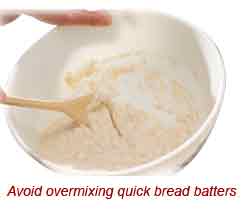 Too much stirring removes air from
the batter and can create a flat product. Instead of
additional stirring, some recipes call for the batter to set 5
minutes so that the dry ingredients can absorb the
liquid. Too much stirring removes air from
the batter and can create a flat product. Instead of
additional stirring, some recipes call for the batter to set 5
minutes so that the dry ingredients can absorb the
liquid.
Why it's
important to mix dry and liquid ingredients separately
- In order to stir the batter as little as possible, mix all
of the dry ingredients of the recipe together allowing the
baking soda and/or baking powder to be evenly dispersed.
Similarly, mix all of the liquids together separately. This
allows for minimal stirring once the liquids are added to the
dry ingredients.
The potency of baking soda and baking
powder diminishes over time. Store baking soda and baking
powder in a cool, dry cupboard. Check expiration dates on
containers when purchasing, and note the date of opening on
the container. Generally, use these products within six months
from opening.
|
Waffles &
Pancakes
|
|
We love our friends' tradition of waffles every Sunday
morning! It's something to look forward to, is deceptively
easy to make, and is a delicious way to enjoy a weekend
morning. And, in our minds, pancakes and sausage make the
perfect quick supper that everyone enjoys! There are just a
few tricks to becoming comfortable with making griddle and
iron breads - we'll share them with you and have you an expert
in no time!
Waffles - Let's
face it, the little pockets in waffles are a bit of genius;
they hold perfect amounts of syrup and toppings while the
delicate crust provides extra delicious golden brown flavor.
To make excellent waffles, follow the tips below!
Choosing a Waffle
Iron - Waffles aren't waffles without the grid of
ridges and valleys. It takes a special cooking iron - a waffle
iron - to get these molded results. Waffle irons come in many
shapes and sizes and produce varying results. Here are some
tips for choosing a great waffle iron:
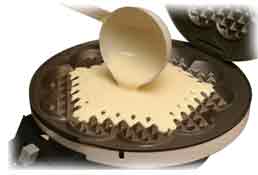 Select a non-stick surface; it
makes removing fresh waffles effortless and clean up easy. Select a non-stick surface; it
makes removing fresh waffles effortless and clean up easy.
- Choose a size that fits your need; there are many
compact waffle irons available that make cupboard storage
very doable.
- Note cord management strategies; a place to wind and
secure the cord makes set-up and storage easy.
- Select a model that has fine controls for heat
management; many models have the nice feature of a "ready"
light when properly heated and when the waffle is done.
- Check the style of handles and ensure that they stay
cool to the touch.
Making Waffles -
Follow the quick bread batter techniques noted above for
making the waffle mix. Follow these steps for great waffles
every time:
-
Place the waffle iron on a level surface with safe cord
arrangements.
-
Preheat the waffle iron in a closed position until very
hot.
-
Use the exact amount of batter prescribed for your
specific iron. This will adequately fill the griddle, yet
not cause an overflowing mess. 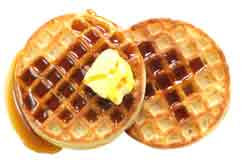 -
Set the level of doneness desired and allow the iron to
do its work; avoid the temptation to peek at the progress.
The perfect waffle is evenly golden -- not too light, not
too dark.
-
Serve waffles as soon as possible - nothing beats the
freshness! If you must, keep waffles warm in a 200ºF oven,
covered loosely, while the second and third batch cook.
-
When finished, allow the waffle iron to cool in an open
position; it will cool more quickly.
Pancakes - A stack
of pancakes, steaming hot, evokes many childhood memories for
us! A pat of butter and a drizzle of syrup complete the
picture!
Choosing a Pancake
Griddle - Pancakes do not require a special iron like
waffles, but may be made on the stovetop or on a flat griddle
of any type. Consider the following when choosing a
pancake-making surface:
-
Choose a pan with a non-stick surface for easy
management and great results.
-
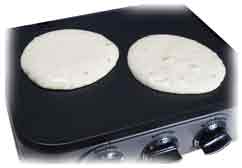 A cast-iron skillet is great for making
pancakes because it recovers its heat quickly after
confronted with cool batter. Make sure it is seasoned well.
Add oil to the pan as it heats removing any excess oil with
a paper towel. -
A stovetop griddle allows for making multiple pancakes
at a time. Choose a stovetop griddle that conducts heat very
efficiently so that there are no hot or cool spots, but only
even heat.
-
A griddle appliance is very useful for pancakes; choose
a griddle whose coils are positioned for even heating across
the griddle, and where the temperature is easily controlled
and responsive.
Making Pancakes -
Follow the quick bread batter techniques noted above for
making the pancake mix. You'll have great pancakes every time
with these tips:
If using a griddle, place it on a level surface with safe
cord arrangements.
-
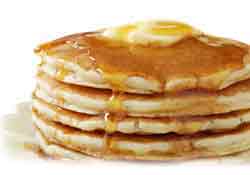 Preheat the skillet or griddle until
hot. -
Test the heat of the pan with a mini-test pancake.
Place a dollop of pancake batter on the hot surface. Adjust
the heat accordingly.
-
Turn the pancake when bubbles float to the top and pop
on the surface of the batter. Turn pancakes only once. The
time required for cooking a pancake will vary based on the
nature and thickness of the batter.
-
If the surface of the pancake is splotchy white and
brown, this may be due to excess oil on the cooking surface;
wipe the surface with a paper towel to absorb any excess oil
and cook the next cake.
-
Serve pancakes fresh from the griddle! As noted above,
if you must keep pancakes warm while additional cakes are
cooking, keep them warm in a 200ºF oven covered loosely with
a square of
foil.
|
Marvelous
Muffins
|
Muffins
are favorite breakfast breads that also fall into the quick
bread category. The flavor and add-in options for muffins are
nearly endless! As easy as muffins are to make, excellent
results are often elusive. Based on the same quick bread
chemistry as waffles and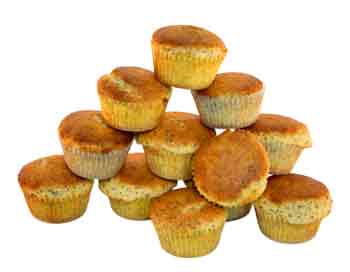 pancakes, use the tips above and the
tricks below to make marvelous muffins every time! pancakes, use the tips above and the
tricks below to make marvelous muffins every time!
There are two things to get right when making
muffins:
Proper Mixing - Mix dry
ingredients together, the wet ingredients together, then
combine the two. Stir by hand only enough to incorporate the
wet and dry together. The most common error when making
muffins is to over mix the batter. The dry ingredients should
just be wet. The batter will be lumpy - that's ok - avoid the
urge to make a smooth batter.
Optimal Oven Temperatures -
When baking, the outside of the muffin is set immediately,
while the inside continues to bake. The batter's bubbles
expand during baking and push the center of the muffin upwards
since there is no other place to go. Muffins generally require
a hot oven - 375ºF-400ºF - to bake properly. Too hot, or too
cool, and the results will be less than
perfect.
If you're having problems baking great
muffins, the shape of a baked muffin will reveal clues to what
is going right and what might be wrong. The ideal muffin has a
nicely domed top, an even, coarse crumb and is done on the
inside without being overdone on the outside.
Sunken/Flat
Muffin - not mixed enough, too low an oven temperature,
too large a muffin cup, or too much, or too little, baking
powder or baking soda.
Pointed Peak
Muffin - results from over-mixing, or too hot an
oven
Perfect Muffin
- mixed just until batter is moistened; oven is the
perfect hotness; batter contains just the right amount of
leavener.
Muffin
Pans - The muffin pan you use will determine any
required adjustments to the recipe. Still use a hot oven, but
adjust the baking time. The smaller the muffin, the shorter
the baking time.
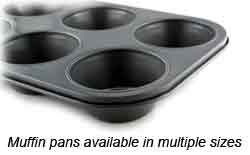 Mini-Muffin
Pans - these cute little minis hold about 1/8 cup, or 2
T. of batter and will take about 6+/- minutes less to bake
than a standard size muffin. Mini-Muffin
Pans - these cute little minis hold about 1/8 cup, or 2
T. of batter and will take about 6+/- minutes less to bake
than a standard size muffin.
Standard Muffin
Pans - these pans hold about 1/2 cup of batter per
muffin. Unless specified otherwise, most muffin recipes assume
a standard muffin size.
Jumbo Muffin
Pans - these pans can hold up to 1 cup of batter and
will take 10+/- minutes longer to
bake.
|
Cucina Fresca's Breakfast
Bread Tips
|
Tip #1: Freeze extra waffles
for your own toaster version of breakfast on the go - they are
incredibly less expensive than boxed, pre-frozen waffle
choices.
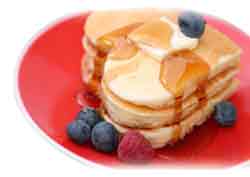 Tip #2: Make pancakes fun by
pouring the batter into special shapes; creatively experiment
with your pouring technique or use special pancake
shape-makers. Tip #2: Make pancakes fun by
pouring the batter into special shapes; creatively experiment
with your pouring technique or use special pancake
shape-makers.
Tip #3:
Use a small sticky note to jot down your favorite
pancake or waffle ingredients and basic instructions. Post the
note on the inside of a cupboard. Quick access to this
information will get you started easily and enjoying your
favorite breakfast bread more often.
Tip #4: Make your own pancake
or waffle mix by combining all dry ingredients together and
storing in a jar, canister, or a zippered plastic bag. Note
the wet ingredients and the ratio of wet to dry on the outside
of the container with a taped note card, or a strip of masking
tape.
Tip #5:
For a fluffier pancake or waffle, separate the egg, beat the
egg whites until stiff, then fold them into the batter as the
last step. The result is a different, lighter
texture.
Tip #6:
Get familiar with your waffle iron and what happens to the
batter as you close the iron. If the batter is pushed forward
from the hinge, adjust the placement of the batter
accordingly.
Tip
#7: Experiment with basic pancake and waffle batters
with the simple addition of cinnamon, or vanilla, or even a
drop of almond flavoring.
Tip #8: Avoid using spray
oils on your waffle iron or muffin tins; an irremovable layer
of "gunk" will result. Instead, use an oil mister equipped
with fresh oil, a brush dipped in oil, or choose an iron or
pan with a non-stick surface.
Tip #9: Use your waffle
iron to make French toast. The grid imprint makes things a bit
more interesting and holds syrup nicely! Try making a grilled
cheese sandwich in your waffle iron or any thin panini-style
sandwich.
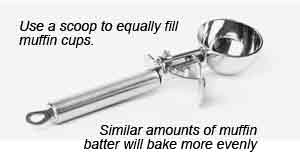 Tip #10: Use a batter scoop
to evenly place muffin batter into the baking cups. This will
help to ensure same-sized muffins and even
baking. Tip #10: Use a batter scoop
to evenly place muffin batter into the baking cups. This will
help to ensure same-sized muffins and even
baking.
Tip #11:
Mix muffins and place the batter in individually lined cups.
Freeze well. Once frozen, store the "nearly ready" muffins in
a zippered plastic bag. When ready to bake, place the frozen
units in the muffin tin and add 10 extra minutes to the baking
time.
|
Q &
A's
|
 Q: What is a Belgian waffle,
and how does it differ from a plain, old
waffle? Q: What is a Belgian waffle,
and how does it differ from a plain, old
waffle?
A: A Belgian waffle is
generally denser and deeper than a traditional American
waffle. The "valleys" are deeper and the overall height
taller. A Belgian variant known as a Brussels waffle is made
with a yeast batter and produces a light and fluffy waffle.
Another Belgian-style, a Liege waffle features pieces of sugar
in the batter that transform into caramelized goodness when
baked.
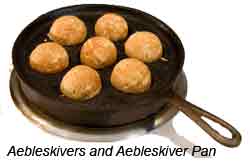 Q: What is an aebleskiver? Q: What is an aebleskiver?
A: An aebleskiver
(translated as "apple slices") is a specialized Danish
pancake. Aebleskivers require a special pan with deep, rounded
wells. The wells hold a batter, which puffs up nicely making a
rounded ball. The aebleskiver is turned with two sticks to
brown the topside. We like to fill the aebleskiver with a
fruit filling. These are a great treat - plan to make a lot of
them for your breakfast crew!
Q: What should I do with leftover
batter?
A: Any leftover waffle
or pancake batter can be kept in the refrigerator in an
airtight container for 1-2 days. Stir the batter before using
to offset any separation that may have happened during
storage.
Q: My
pancakes and waffles are tough and chewy; what's
wrong?
A: Most likely, your
iron or griddle is not hot enough. Try increasing the heat
slightly until the desired result is achieved. If the griddle
or iron is not recovering its heat between cakes, it may be
time for a new appliance; a good griddle or waffle iron should
efficiently and quickly manage a consistently hot
temperature.
|
Cookbook
Review
|
  The Big
Book of Breakfast by Maryana Vollstedt. Copyright 2003.
Published by Chronicle Books LLC, San Francisco,
CA. The Big
Book of Breakfast by Maryana Vollstedt. Copyright 2003.
Published by Chronicle Books LLC, San Francisco,
CA.
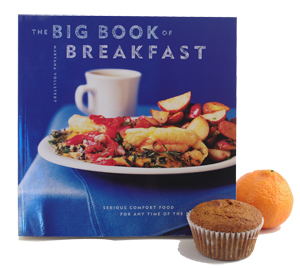 The subtitle of this book says it all -
"Serious Comfort Food for any Time of Day." This well-designed
cookbook covers all manner of breakfasts and breakfast foods.
The recipes are presented simply, yet thoroughly, in eighteen
different chapters focused on different breakfast categories.
The recipes span a broad range of breakfast options ranging
from eggs, casseroles, skillets, pancakes, waffles, crepes,
meats, potatoes, breakfast fruits, and so much more! We
appreciated the inclusion of classic breakfast recipes
presented alongside many creative variations. This book will
be an inspiration for a "breakfast for one," or for a
full-fledged brunch for dozens. What a great way to say 'Good
Morning!' on any day, or at any time of
day! The subtitle of this book says it all -
"Serious Comfort Food for any Time of Day." This well-designed
cookbook covers all manner of breakfasts and breakfast foods.
The recipes are presented simply, yet thoroughly, in eighteen
different chapters focused on different breakfast categories.
The recipes span a broad range of breakfast options ranging
from eggs, casseroles, skillets, pancakes, waffles, crepes,
meats, potatoes, breakfast fruits, and so much more! We
appreciated the inclusion of classic breakfast recipes
presented alongside many creative variations. This book will
be an inspiration for a "breakfast for one," or for a
full-fledged brunch for dozens. What a great way to say 'Good
Morning!' on any day, or at any time of
day!
|
Recipes for Breakfast
Breads
|
Recipes excerpted from The Big
Book of Breakfast by Maryana Vollstedt. Copyright 2003.
Published by Chronicle Books LLC, San Francisco, CA. Reprinted
with the permission of the publisher. All rights
reserved.
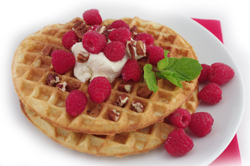 Buttermilk Waffles with Sweetened Cream
Cheese Buttermilk Waffles with Sweetened Cream
Cheese
We love our waffle iron and the
scrumptious waffles it makes! This recipe is a classic. The
buttermilk lends just a hint of tanginess to the finished
result. And, the sweetened, whipped cream cheese with berries
were the perfect visual and gustatory topping to this
beautiful breakfast treat! We can't say "Mmmmm..."
enough!
Click here to view the full,
illustrated recipe.
Click here for a
printable version of
the recipe. (PDF format)
 Sour Cream Pancakes with Blueberry-Maple
Syrup Sour Cream Pancakes with Blueberry-Maple
Syrup
These pancakes are exactly what
pancakes should be - light, perfectly puffed and, oh, so
delicious! The generous dollop of sour cream in the batter is
the secret to their luscious moistness. The fresh blueberries
steeped in genuine maple syrup were a simple discovery that
topped our stack beautifully and tasted
wonderfully.
Click here to view the full,
illustrated recipe.
Click here for a
printable version of
the recipe. (PDF format)
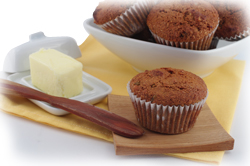 Real Bran
Muffins Real Bran
Muffins
Full of flavor and moistness,
these bran muffins rated five stars on our list of muffin
favorites! The best thing about these muffins is the do-ahead
nature of the batter. Mix it up and bake as desired.
Alternatively, bake the whole batch, cool, wrap individually,
and freeze. They are a great, satisfying answer to those
"grab-and-go" mornings!
Click here to view the full,
illustrated recipe.
Click here for a
printable version of
the recipe. (PDF
format)
| |
Wishing
you great breakfasts any time of
day!
|
|
| |